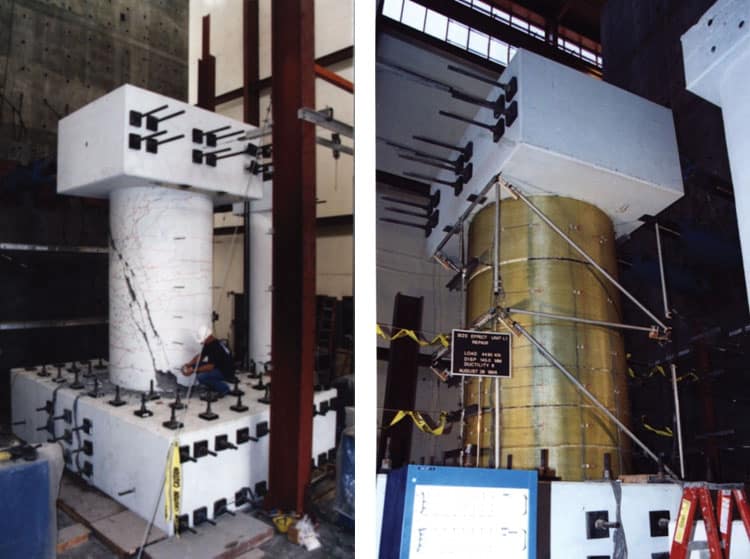The State of the Industry Typically, the term fiber reinforced polymer (FRP) composite is used to describe product applications in the aerospace, military or recreational industries, (e.g. skis, boats, race cars, or golf clubs). However, over the last twenty-five years, the civil infrastructure industry has been conducting continual testing and multi-million dollar project applications of FRP composite materials. Even though the other abovementioned industries have remained the primary consumers, the use of FRP composites in civil infrastructure is fast becoming a major contender.
History of FRP The 1980s brought the first applications in the FRP industry, where research and testing was successfully completed to structurally strengthen and rehabilitate concrete columns as an acceptable alternative to steel jacketing. Its first major breakthrough occurred when seismic retrofits successfully increased the ductility of full-scale reinforced concrete bridge columns (Figure 1). Later testing expanded to include full-scale tests of wall specimens, a five-story masonry research building, a six-foot diameter column and column-arch rib joints. These remarkable tests provided the necessary avenue to develop the industry. To date, the number of applications have grown in leaps and bounds.
Thirty years of testing, designing, and installing FRP systems has proven to be an effective retrofit solution when properly implemented. This implies that structural testing and research are no longer limited to just retrofitting bridge columns, but have now been broadened to investigate other structural elements, such as beams, slabs, walls, and pipes in order to provide shear strengthening, flexural strengthening, axial load strengthening, lap splice enhancements, corrosion repair & protection, and blast mitigation (Figure 2). Recent tests have focused on developing various ways of anchoring and detailing FRP systems in order to improve efficiency and deal with complex geometries. Although there has been a vast amount of research completed, there are still budding areas which have not been fully explored, including using FRP to strengthen steel structures and to provide additional shear resistance to plywood and gypsum wall buildings. As this industry continues to grow, there will always be a corresponding increase in the advances and uses of the FRP composite materials.
Evolution of FRP With each passing year, the number of projects designed and installed can range in price from thousands to multi-million dollars. As engineers become more comfortable and confident with the abilities of FRP, there has also been a growing need to create a design guideline and code for these materials, due to the differences between the different types of systems (e.g. glass fiber systems, carbon fiber systems or aramid fiber systems).
After the 1994 Northridge Earthquake in Southern California, the International Code Council (ICC) Evaluation Service developed the first acceptance criterion for the use of FRP systems as an approved building material, per current building codes, to strengthen both concrete and masonry structures. This acceptance criterion (AC 125) not only states the design requirements for the FRP systems, but also describes the required large-scale structural testing, physical and mechanical properties testing, environmental and durability testing, and quality control measures necessary during installation to obtain approval. The Table gives a brief list of all the required testing to meet the abovementioned requirements. Ultimately, the main objective of AC 125 is to provide confidence to the engineering community in regards to the design and installation of the FRP materials when directly compared to conventional repair methods.
Since this time, the American Concrete Institute has developed, concurrently with the ICC, a design guideline of FRP composites for both concrete (ACI 440.2R-08) and masonry structures (ACI 440.7R-10). This eventually sparked a global chain reaction with over 30 countries around the world now using an approved FRP design code or guideline (Figure 3), including Canada (CSA S806-12), United Kingdom (TR 55/TR 57), Germany (Allgemeine Bauaufsichtliche Zulassung), and New Zealand (CodeMark).
In the end, no matter the size or location of the project, each design and installation is unique and no assumptions can be made purely on the basis of past applications. This means each project will have its own clearly-defined performance criteria, which will be met using the approved design guideline, in order to satisfy the desired design goal. That being said, the contractor also plays an important role in the installation of the FRP composite. If they are not properly trained or certified, this could potentially be a weak link in the success of the FRP system. It is always noteworthy to compare each project with conventional repair methods. Even though FRP is a high cost composite, high strength properties, the ease of installation and the lightweight/low-profile nature have turned it into an excellent tool for strengthening and rehabilitating a variety of structures.
Conclusion The FRP industry first began with seismic retrofits of bridge columns, but has since gained momentum in its variety of applications. Even with the vast amount of research completed, there are still areas where the capabilities of this powerful strengthening tool have yet to be discovered. As research progresses and continues to prove the effectiveness for numerous applications, it will always be necessary to concurrently investigate cost compared to conventional retrofit solutions. This will afford a true understanding of how these relatively expensive materials provide a cost benefit when all aspects of the installation process are considered. At the end of the day, as technology advances and the FRP industry continues to grow, we expect to see the true potential of this industry begin to flourish in the years to come.


بدون نظر